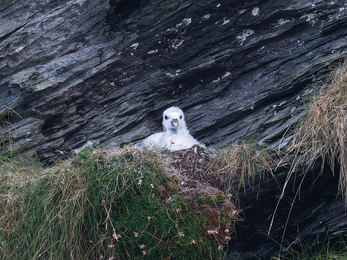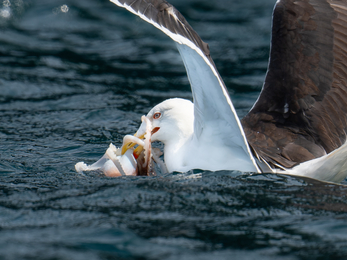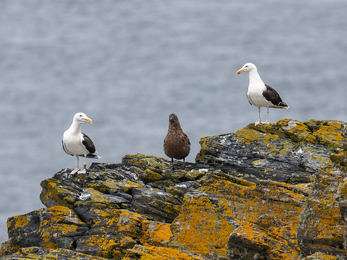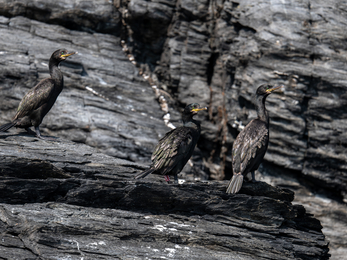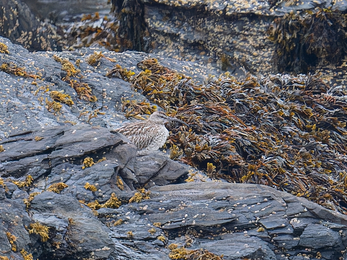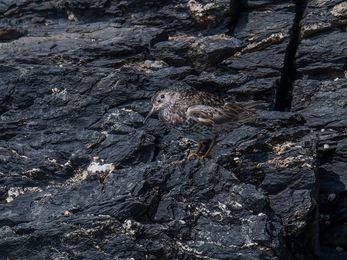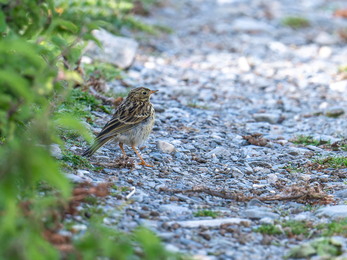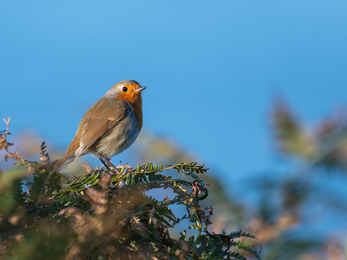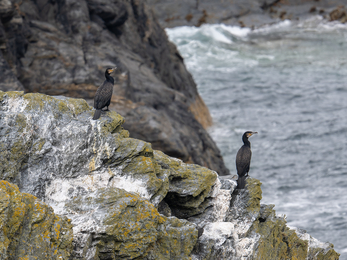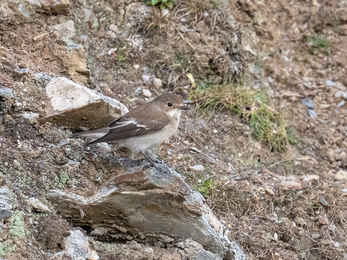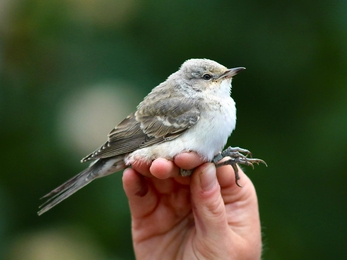The young from the various seabird colonies on the Calf have grown throughout the summer months, exponentially growing and replacing their fluffy down with hardwearing and flight-capable feathers, ready for a life at sea. Breeding totals as follows: Manx Shearwater minimum 950 Apparently Occupied Burrows, Fulmar 93 Apparently Occupied Sites (producing 5 chicks), Common Guillemot 138 pairs, Black Guillemot five pairs, Razorbills 122 pairs, Shags 151 Apparently Occupied Nests, Great Black-backed Gull 73 AONs, Lesser Black-backed Gull 89 AONs, and Herring Gull 589 AONs. Only Fulmars, Manx Shearwaters and a few late-nesting Shags still had young in their nests, but they too will have fledged within weeks.
Adventures in August with the Ornithology Team
©Matthew Livsey
Seabird sightings this month mostly consisted of passage birds and the last remnants of the isle’s breeding birds. The resident Great Skua was present throughout the month, occasionally vanishing for a few days, possibly to visit the Isle of Man, harry a passing Lobster boat or perhaps just evading the keen eyes of the ornithology team. Singles of Sandwich Tern were sighted during seawatches on the 5th and 12th, and the 79th Calf record of Arctic Tern were seen heading south on the 28th. A single Puffin was seen on the same day heading north. 266 Shags were seen on the round-island trip on the 12th and nine Storm Petrels were caught on the night of the 14th, with an additional one on the 22nd. Manx Shearwaters were seen in large numbers this month, with 945 (203 south & 742 north) seen during a seawatch on the 9th. The first stargazing Manx Shearwaters were caught and ringed on the 22nd.
A variety of waders were sighted this month, consisting of young birds dispersing from their natal areas, summer visitors moving south for the winter and wintering birds arriving after concluding their breeding season. Two Lapwing were sighted in the front field on the 1st, singles of Redshank and summer-plumaged Dunlin on the 5th, two Turnstones on 11th, which then increased to nine on the 12th during a round-island trip. The first Purple Sandpiper of the winter was also seen during the round-island trip, inhabiting the dark recesses of the Lighthouse Cave. A Ringed Plover was on about the island from the 14th to the 23rd, mostly hanging out around South Harbour and Kione ny Halby. A single Purple Sandpiper was seen on the 16th at Culbery, a single Turnstone was at the Puddle on 18th and six Redshank were seen on the 21st at Cow. The highest year count of Curlew was 39 individuals in the Front Field on the 29th. There were three records of Common Sandpiper and eight records of Whimbrel (consisting of 1-2 Whimbrel at a time) throughout the month.
Waterfowl records were relatively few this month. The last Eider of the year was a female swimming off Cow on the 2nd and Common Scoter were sighted on the 9th and 28th, with one flying north and nine flying south off Culbery, respectively. There were sporadic sightings of a female Mallard and three fledged ducklings at Cow throughout the month.
Movement of more land-based birds picked up in August. Our ringing records show that the vast majority of passerines (particularly for smaller birds like warblers, finches and pipits) passing through are young birds, embarking on their first migration. The 10th held a flock of 20 Ravens, and single Greenfinch and two Crossbills that briefly visited the conifers outside the Observatory. A House Sparrow visited the Observatory on the 13th and two were seen on the 15th (with a supporting cast of 31 Chough and the first White Wagtail of the autumn). The 16th had a Hirundine theme, with a single Sand Martin, 101 Swallow and 19 House Martin passing through, in addition to an adult female Redstart trapped and ringed at the Observatory. The 17th and 20th had an Osprey heading south. A major arrival of Willow Warblers and Robin occurred on the 21st, consisting of exactly 41 individuals of both species. A dispersing Great Tit was seen on the 24th and passage Tree Pipits were present on 16 out of 31 days this month. The last Cuckoo of the year was seen at Baie n’Ooig on the 27th.
In early to mid August, the Calf was a stop-over point for large flocks of Linnet and Goldfinch, taking advantage of this year’s bountiful crop of Marsh Thistle. Linnet numbers peaked at 166 birds, while Goldfinch numbers peaked at 82 birds earlier in late July. The flocks were fairly nomadic across the island, gathering in areas wherever thistle seeds were plentiful and moving on to another when they had exhausted that supply.
The 10th of August was notable for hosting the new highest day count of Cormorant; 36 individuals, beating the previous highest day count of 29 on 7th September 2006. A flock of 26 was seen flying north over the Glen and an additional seven and three were seen roosting (at Cletts and Ghaw Laing, respectively). Cormorant sightings have steadily been increasing in number in recent years, and we hope that some may start breeding here soon.
The star bird of August was undoubtedly a Red-breasted Flycatcher, spotted foraging around the wall into Gibdale on the 25th. A species that normally resides in eastern Europe during the summer; however, they are strongly migratory, and numerous individuals are sighted in the UK every autumn as birds migrate to their wintering grounds. This was the 31st Calf record, and the first record for August. Unfortunately, it was too mobile and elusive for a photograph, however, a Pied Flycatcher that was sighted in the same location was far more showy (pictured below)..
A close second was an immature Barred Warbler, caught and ringed on the 22nd. Like the Red-breasted Flycatcher, the species normally resides in central and southern Europe during the summer. This individual was caught whilst refuelling on the Calf’s early ripe blackberries.
Another notable bird was the Calf’s 3rd ever 'control' Grey Wagtail, a young bird ringed as a chick near Aberdeen. This is a rare opportunity to know the exact location a bird was born, as most passerines are ringed as fully fledged birds. Now sporting a colour-ring, perhaps it will be resighted again elsewhere.
All in all, it was a great month that filled us with excitement for the autumn ahead!


